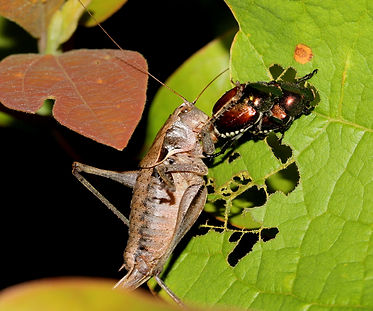Shieldback Katydids

Are they really even katydids? Yes, in fact, they are – but the native ones in particular certainly don’t look like our leaf mimics!
Shieldbacks have a substantial pronotum that looks like a shield. (Below: female Protean Shieldback)

They look like tiny armored tanks – rounded, plump, sturdy - but they are not as invulnerable as they appear and can be seriously injured if dropped. It might be a good idea to leave them where you find them (should you be fortunate enough to locate one) and simply watch what they do - including catching and eating other insects. I observed a Protean Shieldback about to grab and eat a male Japanese beetle that was in the process of mating!


They live in woodland edges and shrubby meadows, and their shades of brown blend very well with bark, shrub stems, and dry leaves. These katydids are generally nocturnal and are predators on smaller insects. Although I seldom see or hear them, they seem to mature in the beginning of July.
The two native shieldbacks in our regions are the Least Shieldback (Atlanticus monticola) and the Protean Shieldback (Atlanticus testaceus). The Least Shieldback can definitely be found in Geauga County and there are records for other counties in our region as well. The Protean Shieldback is more common a little farther south and west but is at the Cleveland Museum of Natural History’s Singer Lake Bog in Summit County.
NE Ohio also has a non-native shieldback katydid from eastern Europe: the Roesel’s Katydid (Roeseliana roeselii). They are small, attractive, green and brown insects that you may think resemble grasshoppers more than katydids. When in doubt, though, remember to check the antennae; they are quite long!
Their song is an electrical buzzing reminiscent of a humming wire. Although non-native, they mature earlier than our native meadow katydids and don’t seem to be a problem. Listen for them in grassy meadows from later June into July.
